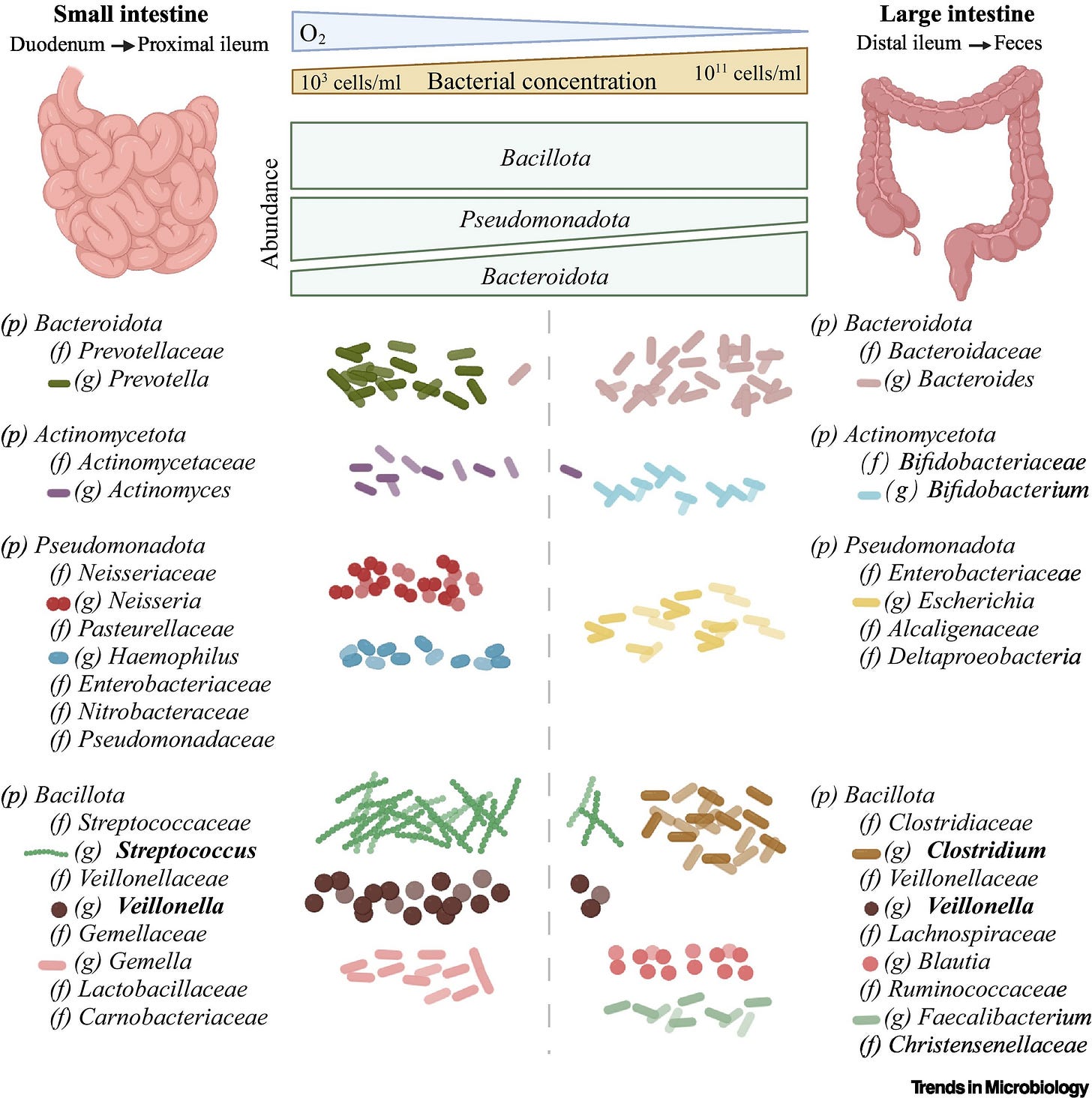Beyond Bloating: Rethinking the Small Intestinal Microbiome
The consequences of SIBO extend beyond digestive symptoms:
If we’re going to advance how we treat gut health, we need to upgrade how we talk about the small intestine.
Most discussions stop at symptoms; bloating, constipation, diarrhea; but behind the curtain lies a complex sensory and immunological hub. The small intestine is not just a conduit for nutrients. It’s a gatekeeper, a neural signaling center, and an immunologic buffer zone ¹.
It’s also home to a unique and often overlooked microbial community; one that may make or break systemic health.
The Hidden Role of the Small Intestine
The small intestine handles almost all nutrient absorption thanks to its surface area-enhancing villi and single mucus layer ². It’s heavily innervated and packed with immune cells, trained to detect threats.
Unlike the colon, its microbial residents are few;but they’re not incidental. These select anaerobes:
Ferment carbohydrates
Produce short-chain fatty acids
Regulate local pH
Generate neurotransmitters like serotonin and tryptophan metabolites ³ ⁴
Generate many of our B-vitamins
Aid in nutrient absorption
This makes the small intestinal microbiome less a bacterial squat and more a precision-tuned organ.
This is image from; (Yersin, S., & Vonaesch, P. (2024). Small intestinal microbiota: from taxonomic composition to metabolism. Trends Microbiol., 32(10), 970–983. doi: 10.1016/j.tim.2024.02.013) beautifully depicts the core roles and species of the small intestine and how species thrive in specific regions of the small intestine based on many factors such as pH. And which nutrients are absorbed in which segments of the small intestine. For example, Iron (Fe) is absorbed duodenum (as is calcium). What would happen the Ph of the small intestine is overly alkaline of if the microbiome core species were outpopulated or hijacked by sibo overgrowth? It also highlighted the core segment specific microbiota. In Sibo -hydrogen dominant; the duodenum becomes over-run with Klebsiella
Again from Yersin, S., & Vonaesch, P. (2024). Small intestinal microbiota: from taxonomic composition to metabolism. Trends Microbiol., 32(10), 970–983. doi: 10.1016/j.tim.2024.02.013. Healthy small intestines contain relatively sparse microbial populations dominated by Bacillota and select anaerobes like Streptococcus and Veillonella. Pathobionts like Escherichia may only dominate in overgrowth states like SIBO.
When Balance Breaks: Dysbiosis and Disease
In hydrogen-dominant SIBO, Klebsiella is a frequent offender, producing inflammatory cytokines like IL-6 and TNF-α ⁵. In methane-dominant overgrowth,Methanobrevibacter smithii generates methane gas that slows motility and disrupts serotonin pathways ⁶.
And in hydrogen sulfide overgrowth, Desulfovibrio species produce gas that, while physiologically helpful in moderation, becomes neurotoxic at high levels ⁷.
These microbes don’t just irritate the gut. They hijack the gut-brain axis, causing symptoms ranging from brain fog to mood shifts ⁸.
Systemic Fallout: From Liver to Brain
Lipopolysaccharide (LPS), a toxin released by gram-negative bacteria, binds to toll-like receptors in distant organs; especially the liver-where it activates inflammatory cascades ⁹.
This has been linked to non-alcoholic fatty liver disease (NAFLD), which co-occurs with SIBO in up to 35% of patients ¹⁰.
And the gut-fibromyalgia connection? A landmark study found 100% of fibromyalgia patients had breath-test confirmed SIBO ¹¹. Pain syndromes may have more to do with the microbiome than we once thought.
Bile, Barrier, and Cancer Risk
Persistent dysbiosis also alters bile metabolism ;increasing secondary bile acids like deoxycholic acid, which can promote inflammation and even colorectal cancer ¹² ¹³.
And it’s not just what the microbes make—it’s what they break. Biopsies show villus blunting in SIBO patients, reducing absorption and increasing intestinal permeability (a.k.a. “leaky gut”) ¹⁴.
The Takeaway
It’s time to stop treating the small intestine like a sidekick. It's a central player in metabolism, immune signaling, and neurological health.
Future therapies will go beyond antibiotics; targeting metabolic signaling, immune balance, and microbial diversity. Until then, consider that your brain fog, fatigue, or elevated liver enzymes may have started in the small intestine.
—
Have thoughts or experiences with SIBO, dysbiosis, or small intestinal health? Let me know in the comments below or join our Circle community for deeper discussion. Note all paid members of my substack get a free year subscription to my Circle Community.
Footnotes
Turner JR. Intestinal mucosal barrier function in health and disease. Nat Rev Immunol. 2009;9(11):799–809.
Helander HF, Fändriks L. Surface area of the digestive tract—revisited. Scand J Gastroenterol. 2014;49(6):681–9.
Martens EC, et al. Interactions of commensal and pathogenic microorganisms with the intestinal mucosal barrier. Nat Rev Microbiol. 2018;16(8):457–70.
Yano JM, et al. Indigenous bacteria from the gut microbiota regulate host serotonin biosynthesis. Cell. 2015;161(2):264–76.
Pimentel M, et al. The role of Klebsiella pneumoniae in hydrogen-dominant SIBO. Gut. 2020.
Chatterjee S, et al. The role of methane in gastrointestinal motility. Neurogastroenterol Motil. 2007;19(9):744–50.
Carbonero F, et al. Hydrogen sulfide: A gasotransmitter of microbial origin in the gastrointestinal tract. Gut Microbes. 2012;3(6):545–53.
Cryan JF, et al. The microbiota-gut-brain axis. Physiol Rev. 2019;99(4):1877–2013.
Cani PD, et al. Metabolic endotoxemia initiates obesity and insulin resistance. Diabetes. 2007;56(7):1761–72.
Compare D, et al. Gut–liver axis: the impact of gut microbiota on non-alcoholic fatty liver disease. Nutr Metab Cardiovasc Dis. 2012;22(6):471–6.
Pimentel M, et al. Small intestinal bacterial overgrowth: a possible link with irritable bowel syndrome and fibromyalgia. Am J Gastroenterol. 2004;99(5):958–64.
Ridlon JM, et al. Bile acids and the gut microbiome. Curr Opin Gastroenterol. 2014;30(3):332–8.
Bernstein C, et al. Bile acids as carcinogens in human gastrointestinal cancers. Mutat Res. 2009;659(1-2):274–91.
Ghoshal UC, et al. Small intestinal bacterial overgrowth and intestinal permeability: their relevance in functional gastrointestinal disorders. J Neurogastroenterol Motil. 2012;18(4):443–53.




